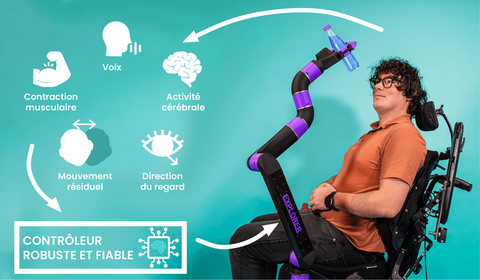The EXTENDER project : helping people with disabilities to operate a robotic arm
The EXTENDER project, winner of the 2023 Robotics Transfer Challenge call for projects (Défi Transfert Robotique), is developing innovative interfaces to enable people with disabilities to control a robotic arm mounted on their wheelchair. This project is led by major actors such as ISIR (Sorbonne University / CNRS), LAAS-CNRS, CETCOPRA (Université Paris 1 Panthéon-Sorbonne), the Auctus project team (Inria Center at the University of Bordeaux), the Pascal Institute (UCA / CNRS, with secondary supervision by CHU Clermont-Ferrand and a member of Clermont Auvergne INP), the start-up ORTHOPUS, and a healthcare center: ESEAN AFP France Handicap. EXTENDER is part of the France 2030 program, operated by the National Research Agency (ANR) and BPI France.
-
Alyssa Perrott
-
01 44 27 47 01

Transferring Academic Robotics Expertise to Enhance the Autonomy of People with Disabilities
French research in robotics excels in the field of collaborative robotic arms, known as "cobots," which are designed to assist, support, or replace human actions in industrial environments. These technologies offer promising solutions for the disability sector, as robotic arms could help people with reduced arm or hand mobility regain autonomy.
The objective of the EXTENDER project is to leverage academic expertise in collaborative robotics, developed in research laboratories, to enable wheelchair users to operate a robotic arm for daily tasks. To accommodate a wide range of situations, the main challenge is to design adaptable and customizable solutions based on users' sensory-motor and cognitive capabilities. The project will explore various interfaces, including smart glasses, augmented reality headsets, voice control with generative AI, muscle sensors, motion sensors, and brain activity sensors.
The robotic arm used for testing will be the ORTHOPUS Explorer, developed by ORTHOPUS. As a socially impactful start-up with ESUS certification, ORTHOPUS designs robotic devices to enhance the autonomy of individuals with muscular weakness in their arms. With the results of the EXTENDER project, ORTHOPUS aims to further its social commitment by developing new technological innovations that promote independence, fulfillment, and inclusion for people with motor disabilities.
The EXTENDER project is entering a two-year research phase, after which an industrialization phase will be considered to commercialize the control solutions. This transition will depend on the effectiveness and relevance of the technologies, both in terms of technical performance and user needs.
Collaboration at the Heart of the Project
Through a multidisciplinary approach, the EXTENDER consortium brings together academic, industrial, and medical expertise, involving:
- Three robotics laboratories: The Institute of Intelligent Systems and Robotics (ISIR, Sorbonne University / CNRS), the AUCTUS project team (Inria Center at the University of Bordeaux), and the CNRS Laboratory for Analysis and Architecture of Systems (LAAS-CNRS)
- One start-up from the Handitech ecosystem – part of the France 2030 program: ORTHOPUS
- Two operators for preclinical testing: ESEAN APF France Handicap and the Pascal Institute (UCA / CNRS, with secondary supervision by CHU Clermont-Ferrand and a member of Clermont Auvergne INP);
- One research unit specializing in the study of technology usage: CETCOPRA (Université Paris 1 Panthéon-Sorbonne), which focuses on socio-anthropological observation and analysis of technology.
In addition to these organizations, wheelchair users will be involved throughout the project in both the design and evaluation of solutions. Test pilots will participate in the international assistive technology competition, Cybathlon. Other users will take part in preclinical alpha and beta testing to assess selected technological components in laboratory trials. The participation of a research team in the socio-anthropology of technology will go beyond simply evaluating the performance of these technologies (usability, safety, efficiency, etc.) to also consider their usage and the socio-cultural context of their development.